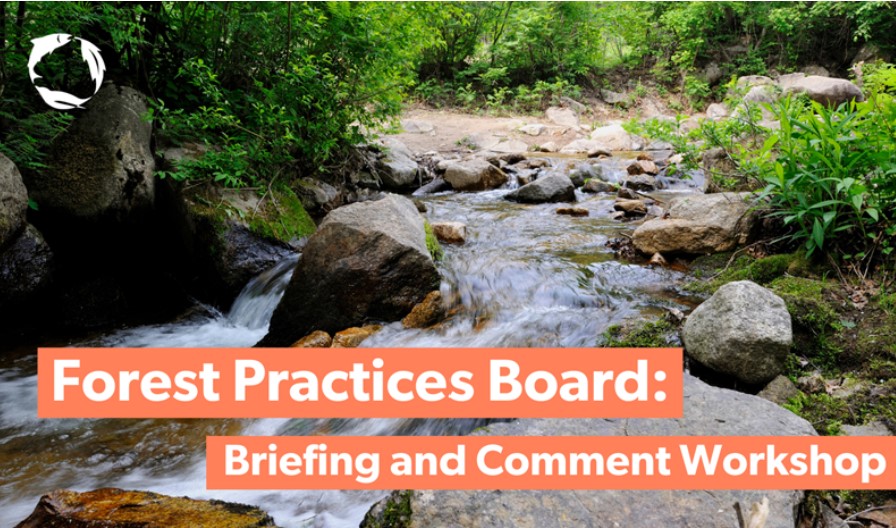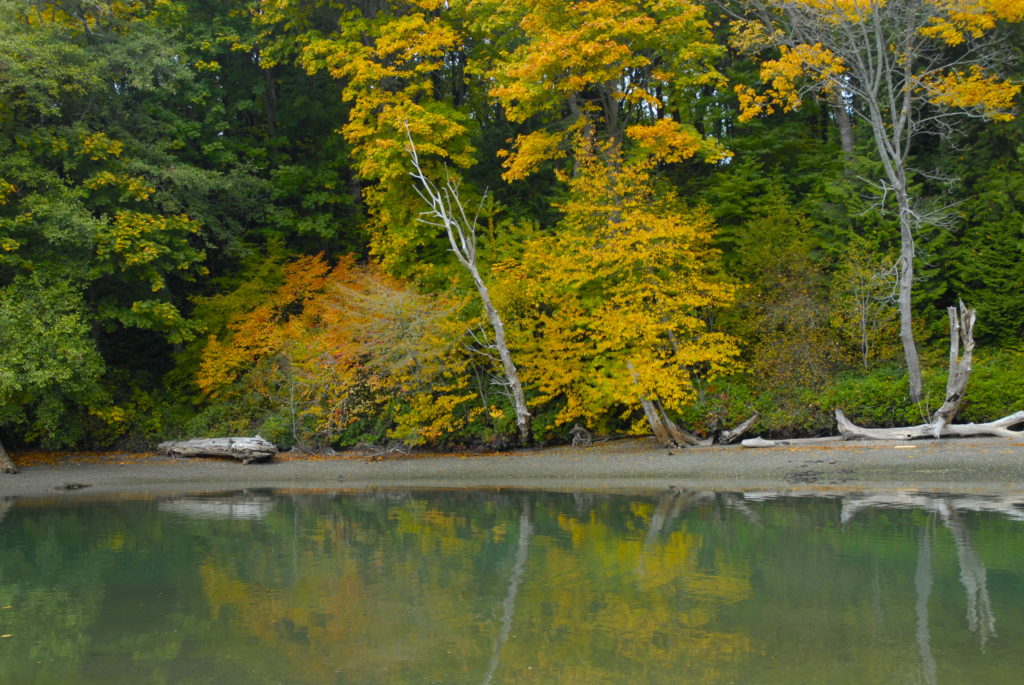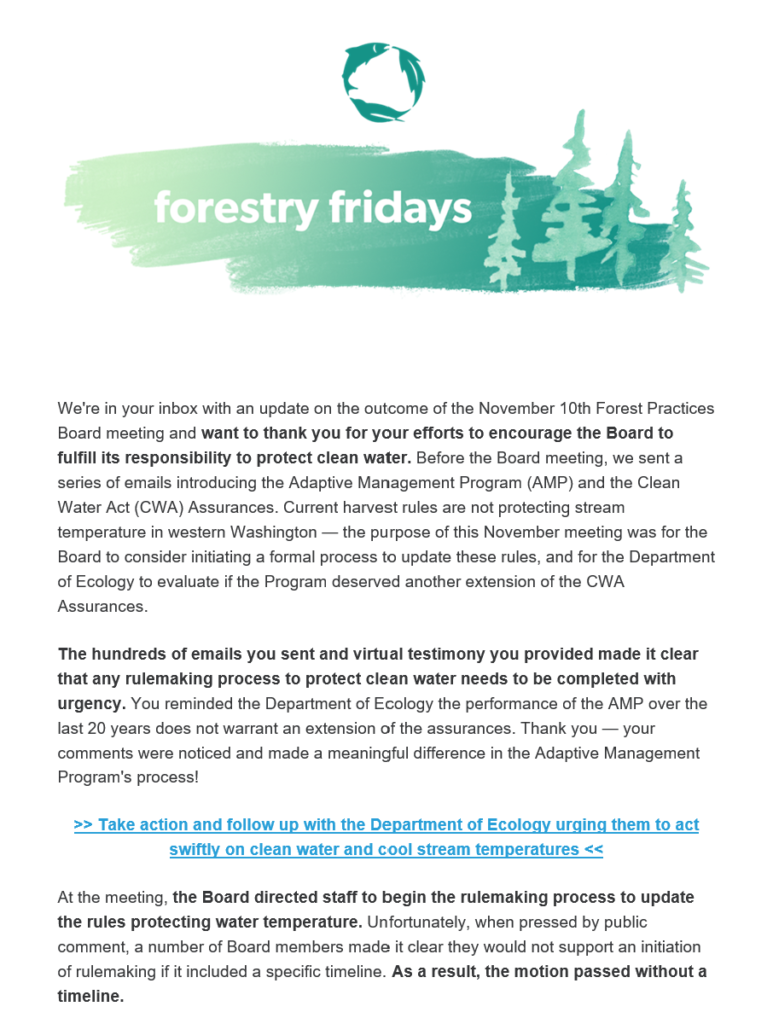Washington’s Adaptive Management Program
Editorial note: The following content was originally featured as an email series in Autumn 2021.
1. Forest Practices Act: Washington’s Tool for Protecting Water Quality and Aquatic Species in the Forested Landscape
Did you know that Washington State is roughly 45,663,000 acres and forests account for more than half of our state at 23 million acres? Washington’s forests provide habitat for critters, animals, and the cool clean water essential for Washington’s aquatic species, including our cherished salmon. They are also among the most valuable timber in the world and have been an important part of the state’s economy for over a century. Roughly 8 million of these acres are owned by private landowners for timber production.
Nearly 50 years ago, Washington Environmental Council (WEC) realized the timber industry’s logging practices were harming the precious natural resources our forests provide. WEC joined tribal leaders and other environmental advocates to pass the Forest Practices Act in the State Legislature — landmark legislation protecting Washington’s working forests.
The Forest Practices Act created the Forest Practices Board (FPB). The FPB is an independent state agency tasked with adopting timber harvesting rules that protect clean water and aquatic species, such as requiring harvests adjacent to streams and wetlands leave the trees that provide these functions. Streams with fish habitat are granted higher levels of protection than streams that cannot support fish. But streams without fish habitat are still protected because they must provide cool water downstream to support healthy habitats.
Timber harvesting rules are enforced by the Department of Natural Resources (DNR), with oversight and consultation by a range of stakeholders including WEC, representing the conservation community. In practice, the system functions as follows: A landowner plans a timber harvest then submits a Forest Practices Application to DNR. DNR then advises the public of the permit application and submits the application for review by four groups:
- The Department of Ecology because they regulate water quality;
- The Department of Fish and Wildlife because they protect Washington’s wildlife;
- The Affected Treaty Tribes because they hold treaty rights to fish; and
- Federal Agencies because they entered into a formal agreement with the state permitting these activities to protect water and endangered species
If any of these groups have concerns, they may visit the site and request amendments to adjust the application. Otherwise, DNR approves the permit for logging.
This system is designed to protect our water quality and aquatic species by ensuring logging follows the rules adopted by the Forest Practices Board. Unfortunately, research has demonstrated that timber harvesting rules for non-fish streams in western Washington are not sufficiently protecting the cool, clean water by which our ecosystems depend.
Today, WEC is engaged in a formal process to meaningfully update these important rules for our forests, our environment, and our futures. In the next section, we’ll describe the weaknesses with the current rules, and the ongoing process to strengthen them

2. History of the Forest Practices Adaptive Management Program
As outlined above, the Forest Practices Board sets timber harvesting rules to protect clean water and aquatic species. The board does this through a stakeholder-led Adaptive Management Program (AMP) that evaluates harvesting rules and recommends changes to them when needed. Washington Environmental Council is a member of the AMP.
Keep reading to learn about the program’s history, where we are now, and how you can get involved.
The passage of the Forest Practices Act in 1974 established the Forest Practices Board, who was responsible for crafting the timber harvest rules for the state. The timber industry and environmentalists spent more than a decade making their respective cases for specific regulations and their enforcement to the Board, in the legislature, and in the media. This led to constant rule changes, inconsistency, and dissatisfaction for all involved.
“In 2018, a 12-year AMP study concluded that current Forest Practices increase temperatures in certain western Washington non-fish bearing streams beyond the temperatures allowed under the Clean Water Act.”
At the same time, the state was working closely with tribes on fisheries management, thanks to the Boldt Decision that reinforced tribal fishing rights. This was a positive development in what had previously been a very acrimonious dispute over natural resource management. With co-management responsibilities newly affirmed by law, tribal attention turned to the rules governing the health and management of the forested streams salmon use as their spawning grounds.
In 1985 — seeking lasting solutions to timber practices and the turmoil of the current stakeholder process — tribal, industry, and environmental leaders began a two-year negotiation of a new system to protect water, wildlife, fisheries, and the timber industry. The result was the Timber, Fish and Wildlife (TFW) Agreement. The agreement was unique in that forest management rules would be agreed to by unanimous stakeholder consensus. The rules would then be monitored and changes could be recommended to the Forest Practices Board as necessary.
Unfortunately, in the 1990s, salmon stocks in Washington continued to decline so the federal government became more interested in Washington’s forest practices. This led the participants in TFW to begin a new round of negotiations to update the rules and formalize the system into state law. This negotiation culminated in the Forests and Fish Report (FFR) of 1999.
The FFR established new timber management rules to protect water quality and aquatic species that comply with the federal Clean Water Act and Endangered Species Act. This led to the establishment of the Adaptive Management Program, where a science committee studies the rules and presents the findings to a policy committee. The policy committee then determines whether the science warrants an adjustment of the rules. If so, the policy committee recommends a rule change or a new rule for adoption by the Forest Practices Board. WEC represents the conservation community in the AMP policy committee.
In 2018, a 12-year AMP study concluded that current Forest Practices increase temperatures in certain western Washington non-fish bearing streams beyond the temperatures allowed under the Clean Water Act. The policy committee agreed that a rule change was likely, but asked the Forest Practices Board for time to develop a recommendation. Simultaneously, the Department of Ecology, which enforces the state’s compliance with the Clean Water Act, informed the AMP that the agency would like to see rulemaking progress by the end of 2021.
As that deadline approached, WEC worked with the other stakeholders of the AMP to finalize a recommendation for the Board to protect streams and keep them cool. The Forest Practices Board held their final meeting of 2021 on November 10th. You can find out how public voices impacted the outcome of this meeting in section 4!

3. Forests, Clean Water Act Assurances, & Stream Temperatures
In the previous sections, we introduced you to the science-based Forest Practices Adaptive Management Program (AMP). The AMP evaluates how well the Forest Practices rules protect clean water and provide healthy aquatic habitat. Knowing that the AMP changes rules if they are inadequate, the Washington State Department of Ecology granted the program Clean Water Act Assurances. These Assurances allow the program and timber harvests to operate with an understanding that their activities comply with Washington’s Water Quality Standards.
The rules adopted by the Forest Practices Board were formed in policy negotiations informed by science. Some rules were thought to be riskier to aquatic resources than others, so the Department of Ecology prioritized the evaluation of some rules.
One of these rules is the protection of headwater streams in Western Washington without fish habitat. The functions provided by these headwater streams are critical to the health of the downstream fish habitat sheltering salmon. These streams were considered to have a “moderate to high risk of temperature increases.” The program initiated a study in these headwater streams to address concerns about the risk of temperature increases.
In 2018, study results found these streams increased in temperature on average 1.2 degrees Celsius. Washington’s Water Quality Standards limit maximum increases at 0.3 degrees Celsius. As a result, the AMP Policy Committee advised the Board that a rule change was needed, but requested time to consult with experts to recommend new rule language. This process was expected to take until 2021.
At the same time, the Assurances were under review by the Department of Ecology for extension, having been previously extended in 2009. The extension was granted to achieve a series of milestones for another extension to be warranted. Many of the milestones needed for the extension were not achieved by 2019. Despite this fact, the Director of Ecology decided to align a new extension of the Assurances with the rulemaking timeline the AMP had set. The Assurances were extended until December 2021, with a declaration that they would again be considered for extension if significant progress had been made.
Three and a half years have passed since the AMP determined timber harvests in headwater streams are causing temperatures to increase above levels allowed in the state’s Water Quality Standards. The AMP continues to work on a potential new rule, with little progress. Board staff have issued public statements saying a new rule is not feasible until the middle of 2023 at the earliest, a full five years after the study was completed. The Department of Ecology should have no confidence the AMP can protect water quality in headwater streams, and should not extend the Assurances again.
At the November 10th, 2021 Board meeting, the Board considered initiating a formal rulemaking process to determine new rules for harvests in Western Washington’s headwater streams. This announcement to the public, while promising, had no timeline and had the potential to last indefinitely. That is why we asked our members to urge the Board to act with urgency and commit to respond to the AMP study results in a timely manner.
This was our call to action:
In the coming week, you have an opportunity to make your voice heard and encourage the Forest Practices Board and the Department of Ecology to protect Washington’s headwater streams.
Send letters to the Department of Ecology here and the Forest Practices Board here <<
To make your letters more impactful, consider adding brief text to describe your personal stake in the issue and why you care.
Thank you for all you do to protect our forests and fish.
P.S. Want to take the next step? Give public testimony at the Forest Practices Board meeting on November 10th. The meeting is 9am-3:40pm, and public comment on this topic begins at 11:25am. You can find the agenda and zoom meeting link here. Feel free to reach out to alec@waconservationaction.org if you would like support or feedback on your public comment.
4. Outcomes and Future Efforts for Clean Water Rulemaking
To better share the outcomes and future efforts of the AMP, we’d like to highlight our communications where we updated members on the outcome of the November 10th Board meetings and future needs.
On December 3rd, 2021 our members received the following message from us:

Ahead of the November 10 meeting, our members sent hundreds of emails and provided virtual testimony to make it clear that any rulemaking process to protect clean water needs to be completed with urgency. Our members reminded the Department of Ecology their performance of the AMP over the last 20 years does not warrant an extension of the assurances.
At the meeting, the Board directed staff to begin the rulemaking process to update the rules protecting water temperature. Unfortunately, when pressed by public comment, a number of Board members made it clear they would not support an initiation of rulemaking if it included a specific timeline. As a result, the motion passed without a timeline.
This was not the outcome we wanted, but the resulting conversation made it clear that some Board members are not interested in expeditiously updating the rules. Additionally, the Board was informed by AMP staff that even with a smooth process, it would be optimistic to expect the rule processes to complete in 2023 — a full five years after the Program received study results indicating temperature standards were not being met. It’s clear that this Program is not functioning effectively.
At the Board meeting, Director of Ecology, Laura Watson, spoke to the need for a new rule and stated that the Program needs to “move with all deliberate speed” to address the Clean Water Act standards. Given the conversation in front of the Board, Director Watson questioned whether all participants believed a rule change was necessary to protect water temperature. She then declared she would not announce the fate of the Assurances before fully processing the discussion from the meeting.
For the future of our forests and fish, we need to keep the pressure on and make sure the Forest Practices Board and Department of Ecology act urgently on this rulemaking process.
Your tax-deductible donation ensures a sustainable future.
